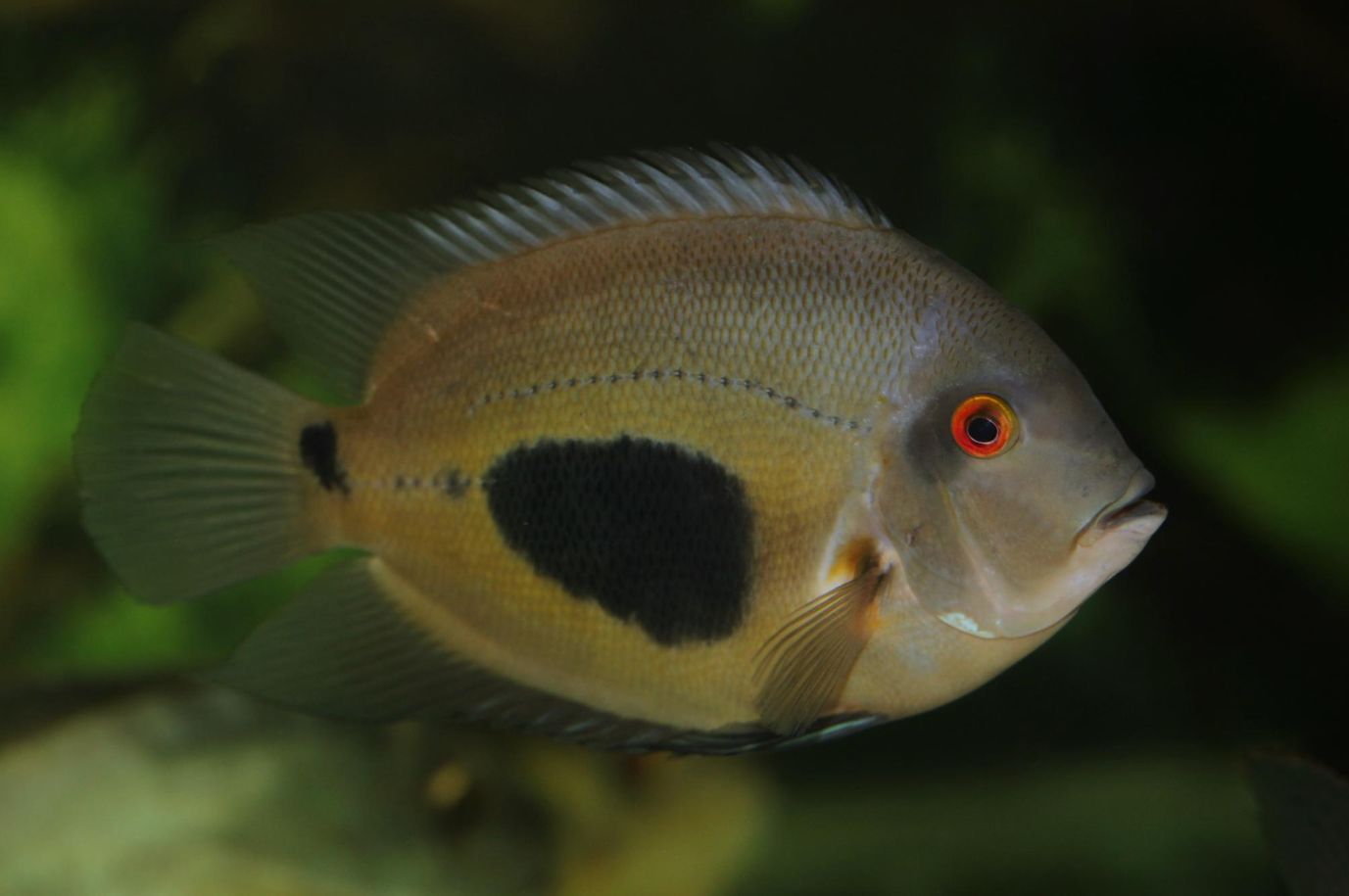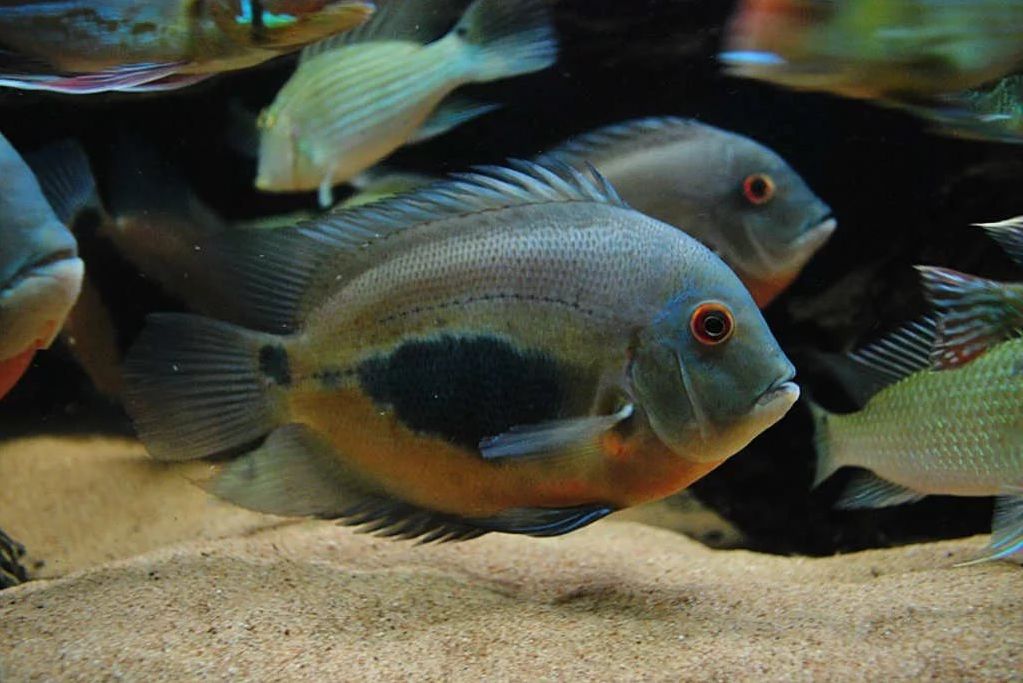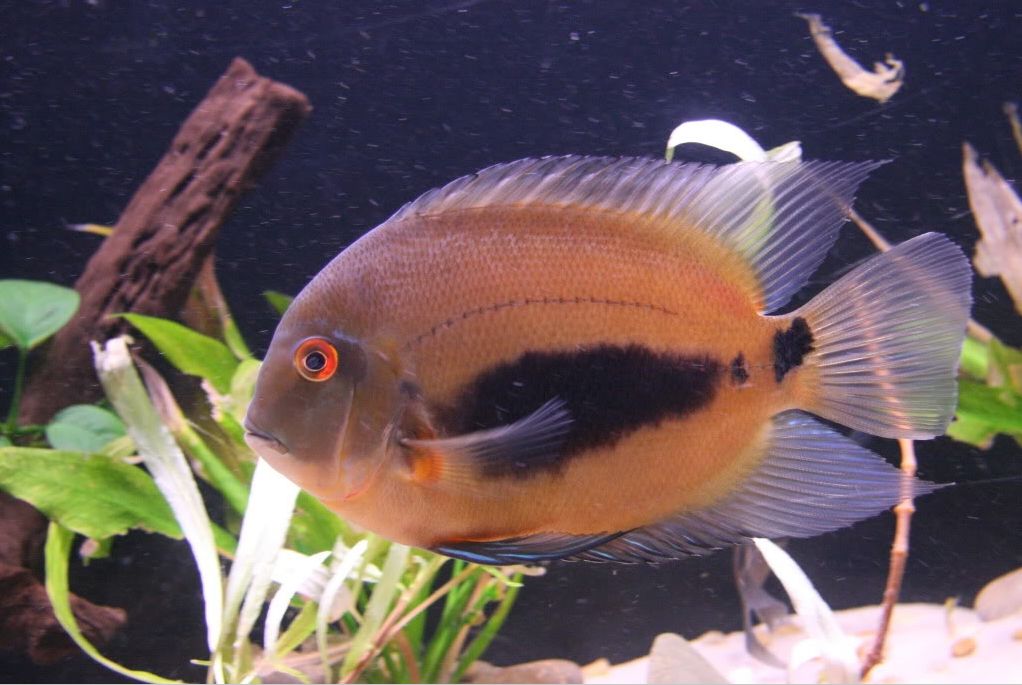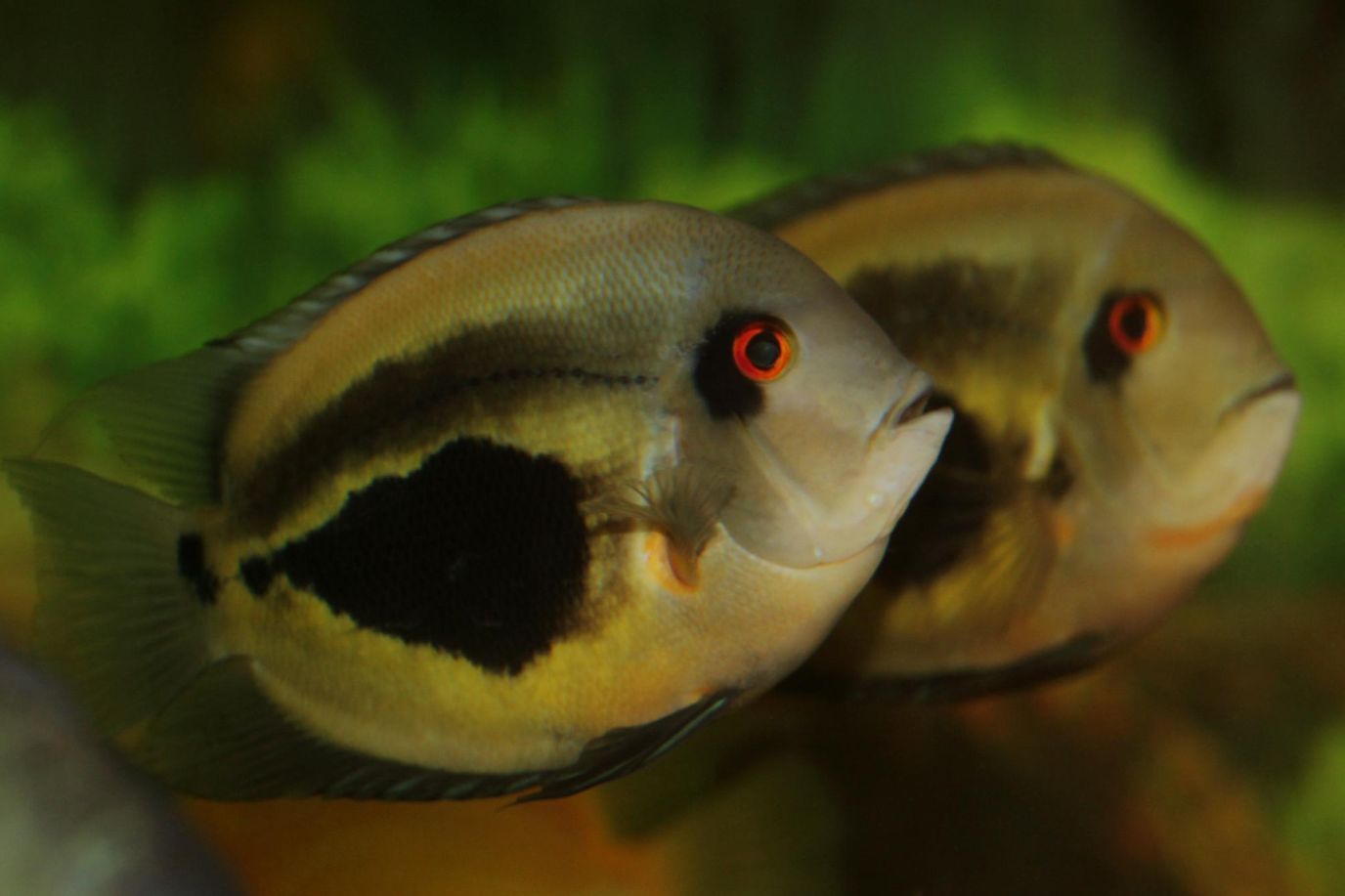The uaru cichlid is a fascinating freshwater fish belonging to the Cichlidae family, known for its vibrant colors and engaging behavior. This large aquarium fish thrives on a diet rich in plant matter, making it a unique choice for aquarists. In this article, you will learn how to create an ideal environment for your uaru cichlid, including the best feeding practices, compatible tank mates, and breeding techniques to ensure a thriving community in your aquarium. Whether you’re a beginner or an experienced aquarist, these insights will help you care for this captivating species and appreciate its role in your aquatic setup.

Contents
Habitat in the wild
The uaru cichlid, known scientifically as Uaru amphiacanthoides, is a captivating member of the Cichlidae family, which encompasses a diverse range of freshwater fish species. Cichlids are celebrated for their vibrant colors, unique behaviors, and intriguing breeding habits, making them a popular choice among aquarium enthusiasts.
Native to South America, specifically the Amazon River Basin, uaru cichlids are recognized for their peaceful demeanor and striking appearance. The species name, amphiacanthoides, is derived from Greek, where “amphi” means “around,” “acanth” refers to “spine,” and “oides” translates to “alike.” This nomenclature reflects similarities in body shape and feeding preferences between uaru cichlids and fish from the Acanthurus genus, which includes about 30 herbivorous species primarily found in the Western Ocean.
The name “uaru” originates from local indigenous tribes who refer to the fish as “uaru ura,” meaning “mirror-like,” likely due to its saucer-shaped body. In their native habitat, these fish can be found in the Amazon River basin and the fresh waters of Guiana, where they thrive in environments with complex underwater topography. Uaru cichlids prefer slow-moving waters with thick vegetation and varied substrates, including stones and driftwood, which provide safety and shelter.
First described by Heckel in 1840 as a large cichlasoma, uaru cichlids made their way to Europe in 1913 and were first bred at the Nuremberg Zoo. In the wild, these fish thrive in slightly mineralized waters with a pH level below 7, and they prefer clean, soft environments. Their diet consists of worms, crustaceans, insects, detritus, fruits, and algae, making them omnivorous.
Unlike other species, such as discus or freshwater angelfish, which often school together, uaru cichlids prefer to remain in pairs or small groups. This behavior makes them less commonly encountered in the wild and presents specific challenges for anglers trying to catch them.

Description
Size
Uaru cichlids are known for their impressive size compared to many other freshwater aquarium fish. In their natural habitat, these fish can grow to a substantial length of 12 to 14 inches (30 to 35 cm). However, when kept in an aquarium, their size is typically smaller, reaching about 8 to 10 inches (20 to 25 cm). This size still makes them a prominent and visually striking presence in a suitably sized tank.
Growth rate
The growth rate of uaru cichlids can vary significantly due to several factors, including genetics, diet, water conditions, tank size, and overall care. Unlike some other cichlid species that experience rapid growth, uaru cichlids are generally characterized by a slower and more steady growth pattern. This means that their size increases gradually over time. Uaru cichlids can reach their maximum size of around 8 to 10 inches in captivity over a period of several years, depending on care quality.
Lifespan
Uaru cichlids can live for approximately 12 to 15 years in a well-maintained aquarium. However, to maximize their lifespan, it is crucial to provide them with the right conditions. This includes maintaining stable water parameters, offering a balanced diet, and ensuring adequate space for swimming and growth.
Body
The uaru cichlid is characterized by a distinctly flattened, egg-shaped body, which contributes to its unique silhouette. The fish’s forehead slopes gently to the beginning of its dorsal fin, enhancing its streamlined appearance.
In adult specimens, the predominant color is a striking yellow-brown, complemented by a prominent triangular dark spot located on the side of the body. This feature has led to several common names for the species, with “triangle cichlid” being the most recognized. Additionally, there is a smaller dark spot near the eyes that adds to their visual appeal.
Uaru cichlids have relatively large eyes, which can vary in color from bright yellow to deep red. This eye coloration stands out against the darker hues of their body, making them particularly captivating to observe. The combination of their unique body shape and vibrant eye color makes uaru cichlids a striking addition to any aquarium.
| Characteristic | Description |
|---|---|
| Scientific Name | Uaru amphiacanthoides |
| Common Name | Uaru cichlid |
| Family | Cichlidae |
| Origin | South America, primarily in the Amazon River Basin |
| Size | Up to about 10-12 inches (25-30 cm) |
| Lifespan | Around 10-15 years in captivity |
| Behavior | Generally peaceful, but can become territorial |
| Tank Size | A larger tank with a minimum of 75 gallons is recommended |
| Water Parameters | Temperature: 75-82°F (24-28°C); pH: 6.0-7.5 |
| Diet | Omnivorous; prefers a variety of plant and animal matter |
| Coloration | Attractive with metallic blue-green body and red eyes |
| Breeding | Parents care for eggs and fry |
| Tank Setup | Plants, driftwood, and hiding spots; soft substrate |
| Compatibility | Generally compatible with other peaceful cichlids |
| Special Considerations | Sensitive to water quality, regular water changes needed |

Difficulties in keeping
Uaru cichlids are relatively undemanding fish, yet they are considered quite rare in the aquarium trade. Despite their somewhat menacing appearance, these cichlids are generally peaceful and show little interest in smaller tank mates. Most of the time, they prefer to stay in their shelters or form groups with other uaru cichlids, typically occupying the middle to bottom layers of the water column.
A well-planned aquarium housing a group of adult uaru cichlids can be a magnificent spectacle. In a large tank, richly decorated with driftwood, rocks, and plants, complemented by dim, colorful lighting, these fish display their natural beauty and social behaviors.
During the 1960s and 1970s, when aquarists primarily had access to wild discus fish—which were often very expensive—uaru cichlids earned the nickname “poor man’s discus.” Both juvenile and adult uaru cichlids were typically sold for less than one-third of the price of a single discus, making them a more budget-friendly option for enthusiasts.
The resemblance in body shape and behavior between uaru cichlids and discus fish contributed to this comparison. Uaru cichlids exhibit similar rounded bodies and social behaviors, attracting aquarists looking for beautiful fish without the hefty price tag associated with discus.

Care and keeping in a tank
Tank size
The recommended tank size for uaru cichlids depends on several factors, including the number of fish you plan to keep, their size, and the potential tank mates. Uaru cichlids can grow relatively large, so they require a spacious environment to thrive. A larger tank not only accommodates their size but also provides ample swimming space, reduces stress, and helps maintain stable water conditions.
For a single uaru cichlid, a minimum tank capacity of 75 gallons (284 liters) is recommended. This size allows the fish enough space to swim comfortably and explore its environment.
If you intend to keep a breeding pair of uaru cichlids, a larger tank is essential to provide sufficient territory and accommodate their potential offspring. A tank with a capacity of at least 100 to 125 gallons (379 to 473 liters) would be more suitable for a pair.
For those looking to create a community tank with uaru cichlids and other compatible species, a larger setup is advisable to ensure all fish have adequate space. A tank with a capacity of 100 to 150 gallons (379 to 567 liters) or more is appropriate for such arrangements.
As the number of uaru cichlids and other fish in the community increases, the tank size should also expand. Providing enough space helps to reduce aggression, maintain water quality, and ensure the well-being of all inhabitants. Additionally, incorporating ample hiding spots and decorations enhances the environment, allowing uaru cichlids to exhibit natural behaviors and feel secure.
Water parameters
Maintaining appropriate water parameters is crucial for the health and well-being of uaru cichlids in an aquarium. These parameters should closely replicate the conditions found in their natural habitat in the Amazon River Basin.
The recommended water parameters for uaru cichlids include:
- Temperature: Aim for a range of 75-82°F (24-28°C). Uaru cichlids thrive in slightly warmer water temperatures, which promote their overall health and activity. While they can tolerate short-term drops in temperature down to 20°C, frequent fluctuations should be avoided as prolonged cold can negatively affect their health.
- pH: A stable pH between 6.0 and 7.5 is ideal. Uaru cichlids prefer slightly acidic to neutral water, and maintaining this range is essential for reducing stress and supporting good health. Soft, slightly acidic water is often achieved through the use of peat moss or specific filtration media designed to lower pH.
- Hardness (GH and KH): Both general hardness (GH) and carbonate hardness (KH) should be kept within 2-10 dGH. Uaru cichlids come from regions with relatively soft water, so ensuring the hardness is within a moderate range is important for their well-being.
- Ammonia, Nitrite, and Nitrate: Ammonia and nitrite levels must remain at 0 ppm, while nitrate levels should ideally be kept below 20 ppm. Regular water changes and proper filtration are essential for maintaining these levels and ensuring a healthy environment.
- Water Movement and Filtration: Uaru cichlids prefer gentle to moderate water movement. A quality filtration system is necessary to maintain water quality, but strong currents should be avoided, as they can stress the fish.
Stability is key when it comes to water parameters. Sudden changes can stress uaru cichlids, making them more susceptible to diseases.
Tank setup: decorations and plants
Wild uaru cichlids are extremely timid and often seek refuge in the shadows of snags in their natural habitat. To replicate this behavior in an aquarium, it’s essential to provide ample shelters and dark areas where they can feel secure. Scattered lighting in the tank is preferable, as it mimics their natural environment and helps create a comfortable atmosphere.
As herbivorous fish, uaru cichlids have a strong inclination to eat aquatic flora. This tendency makes planting live plants in the tank largely impractical, as they will eventually be consumed. Uaru cichlids don’t just nibble on plants; their approach resembles a determined effort to completely eradicate them. I once observed an adult uaru teaching a young one how to eat Vallisneria leaves, which was both fascinating and somewhat alarming. Over three years of keeping these fish in my tank, not a single plant survived.
Understanding these behaviors is crucial for creating an appropriate habitat for uaru cichlids. By providing adequate shelter and managing expectations regarding live plants, aquarists can enhance the overall well-being of these captivating fish.
In their natural environment, uaru cichlids engage in various social behaviors, often forming strong pair bonds. They are known for their playful interactions, especially among juveniles, which can include chasing and exploring their surroundings. While live plants may not thrive in an aquarium with uaru cichlids, incorporating artificial plants or decorations that mimic their natural habitat can provide enrichment without the risk of destruction. Additionally, offering a varied diet that includes high-quality herbivorous pellets and fresh vegetables can ensure their nutritional needs are met while minimizing their impact on any surviving aquatic flora.
Filtration
Uaru cichlids are particularly sensitive to nitrogen compounds in the water, making effective water management essential for their health. In an aquarium, implementing efficient biological filtration is crucial, and using canister filters is highly recommended for maintaining optimal water quality. Regular aeration will also help keep the water well-oxygenated, which is vital for the overall well-being of these fish.
To ensure a healthy environment, frequent water changes are necessary. It is recommended to replace at least 30% of the tank volume every week. This practice not only helps to dilute harmful nitrogen compounds but also promotes stable water parameters, which is especially important for uaru cichlids.
Diet
In the wild, the diet of adult uaru cichlids consists of approximately 80% plant matter, with the remaining 20% derived from animal-based foods. In an aquarium setting, their preferred plant-based foods include duckweed, cabbage, lettuce, spinach, dandelion (often referred to as blowball), sliced apples, cucumbers, and zucchini. However, it’s important to note that spinach should not be offered as a regular part of their diet, as its leaves contain oxalic acid, which can be harmful over time.
When providing plant foods, it’s essential to wash all greenery thoroughly, bundle it together, and then weigh it down before placing it in the tank. This method prevents the plants from floating away and ensures that the uaru cichlids can easily access them. They typically consume these offerings very quickly.
A deficiency in plant-based food can lead to health issues in uaru cichlids. When lacking adequate greenery, they may develop deficiency diseases and start gnawing on round snags in the tank, a behavior that is easily observable.
Uaru cichlids also consume protein-based foods, such as worms, bloodworms, and tubifex. However, these types of food can sometimes carry infectious agents and parasites, posing a risk to the fish. Given that uaru cichlids are relatively large and have a long lifespan, it is advisable to feed them high-quality artificial pellets formulated specifically for cichlids. These specialized foods are rich in nutrients and help mitigate the risk of introducing infections into the tank, contributing to a healthier and more stable environment for your fish.
Tank mates
Uaru cichlid isn’t a fish for community tanks with small fishes (even though it is not aggressive, but this is a large cichlid, and small-sized tank mates it treats as food). However, it is good for dwelling together with other cichlids of Central and South America. These cichlids are less aggressive than their relatives from Africa, but in general, it depends on the tank size.
Uaru can be kept together with discus fish (however, this sensitive fish isn’t the best tank mate in this case), with keyhole cichlid, Texas cichlid, firemouth cichlid, blue acara, convict cichlid, green terror cichlid, blood parrot cichlid, and freshwater angelfish.
In general, it gets on well with any cichlid, on the condition that the latter don’t demonstrate aggression towards it. Avoid aggressive or territorial species, as uaru cichlids can be easily stressed by such tank mates.
Uaru is a social fish, and it should be kept at least as a couple, and keeping several species will be even better. In this case, they create a hierarchy and demonstrate the best of its behavior. However, such a group will require quite a spacious tank.
Gender differences: male vs female
Distinguishing between male and female uaru cichlids can be quite challenging, as the visual differences between the sexes are not as pronounced as in some other cichlid species. However, there are several subtle characteristics to look for that may help in identifying them:
Size: Generally, mature male uaru cichlids tend to be slightly larger and more robust than females. This size difference may become more noticeable as they reach maturity, although it can vary among individual fish.
Body Shape: Males often have a more elongated and pointed dorsal fin compared to females. However, this difference may be subtle and not easily recognizable, especially in well-fed and healthy fish.
Breeding Behavior: During the breeding season, behavioral differences can become apparent. Females typically exhibit a rounder belly when carrying eggs, indicating they are gravid. They may also become more territorial as they prepare for spawning.
Egg Spots: In some instances, males may display small egg spots, which are tiny white or pale spots located on the anal fin. However, this characteristic is not always present and can be difficult to distinguish.
Vent Shape: Some experienced fishkeepers note a subtle difference in the shape of the vent (the opening near the anal fin) between males and females. Males are thought to have a more pointed vent, while females have a more rounded vent. This can be difficult to observe and may require a trained eye.

Breeding
Couples of uaru cichlids typically form only during the spawning period. During this time, males can exhibit increased aggression as they establish territory. However, they may be vulnerable to attacks from other, more aggressive species, even those that are smaller in size, which can drive uaru cichlids away from their chosen spots.
Uaru cichlids reach reproductive maturity at around 16 to 18 months of age and when they attain a size of 18 to 20 cm. Breeding them in an aquarium can be quite challenging, but it shares similarities with the breeding processes of other cichlid species, particularly those from Africa. The success of breeding uaru cichlids largely hinges on selecting the right pair of breeders; it is advisable to start with a group of 8 to 10 young fish. Prior to spawning, feeding the fish a diet rich in sliced cucumbers is beneficial, as it promotes the development of their reproductive organs.
Once a pair forms, they typically spawn in the same tank where they reside, choosing the most shaded area for this purpose. If desired, you can transfer the breeders to a separate spawning tank measuring about 40 inches (100 cm) long, equipped with shelters. The optimal water parameters for spawning include a temperature of 27 to 30 °C, a hardness of 2 to 12° dGH, and a pH between 5.5 and 6.
A successful breeding pair may spawn repeatedly over time. A smooth substrate, such as a large stone, flower pot, or any object with a flat surface, can serve as an effective spawning surface. During the spawning process, which lasts approximately two hours, the female can lay between 150 to 500 eggs, which are small and bright yellow.
Newly-minted parents may occasionally consume their first clutch of eggs. To prevent this, you can remove the eggs to a separate tank. Good breeders that care for their offspring effectively tend to produce juveniles that grow faster than those in incubators. However, conflicts may arise between the breeding pair regarding the care of their young, in which case one of the breeders should be removed to prevent further fighting.
At a temperature of 30 °C, the incubation period for the eggs lasts about two days. The breeders will gather the larvae and place them into a hole they have dug in the substrate. On the third day, the larvae will congregate into a ball-like school and remain in this formation for an additional two days before developing into juveniles and starting to swim actively.
Similar to discus fish, uaru juveniles rely on the epithelial secretory product on the body surface of their parents as their first source of nutrition. While one parent rests, the other carries the young on its body, and they switch roles periodically. In a home aquarium, the epithelial secretory product may be limited or absent, so it’s crucial to provide the juveniles with tiny plankton as their initial food source. As they grow, they will eagerly consume standard animal-based foods.
In addition to traditional protein sources, juvenile uaru cichlids should also be offered duckweed. By the time they reach three months of age, their dietary preferences tend to shift significantly, and they will enjoy foods like spinach, lettuce, and dandelion leaves.
Juvenile uaru cichlids display a striking violet-blue coloration adorned with white spots scattered across their bodies and fins. However, only about one-third of these juveniles will grow to adulthood. Due to the rarity of uaru breeding in captivity and the limited imports from Brazil, the population of this fish in aquariums is steadily declining. Consequently, the price of uaru cichlids has significantly increased.